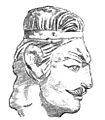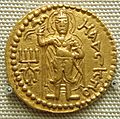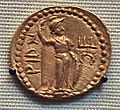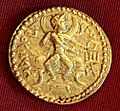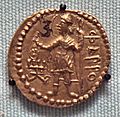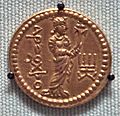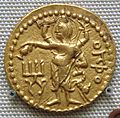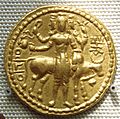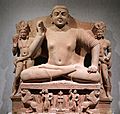Kushan Empire facts for kids
Quick facts for kids
Kushan Empire
|
|||||||||||||
|---|---|---|---|---|---|---|---|---|---|---|---|---|---|
| 30–375 | |||||||||||||
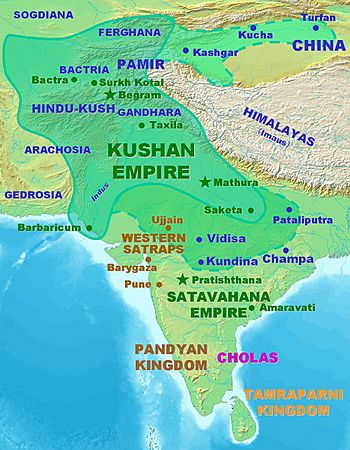
Kushan territories (full line) and maximum extent of Kushan dominions under Kanishka (dotted line), according to the Rabatak inscription.
|
|||||||||||||
| Capital | Peshawar Begram Taxila Mathura |
||||||||||||
| Common languages | Pali Prakrit Bactrian Sanskrit Greek |
||||||||||||
| Religion | Hinduism Buddhism Zoroastrianism Greco-Buddhism Ancient Greek religion |
||||||||||||
| Government | Monarchy | ||||||||||||
| Emperor | |||||||||||||
|
• c. 60-c. 80
|
Kujula Kadphises | ||||||||||||
|
• 350–375
|
Kipunada | ||||||||||||
| Historical era | Classical Antiquity | ||||||||||||
|
• Kujula Kadphises unites Yuezhi tribes into a confederation.
|
30 | ||||||||||||
|
• Subjugated by the Gupta Empire.
|
375 | ||||||||||||
| Currency | Kushan Drachm | ||||||||||||
|
|||||||||||||
| Today part of | |||||||||||||
The Kushan Empire was a powerful ancient empire that began around the early 1st century AD. It covered a large area, including parts of modern-day Afghanistan, Pakistan, and northern India.
The Kushans were originally a group of nomadic people called the Yuezhi. They lived in eastern Central Asia before moving southwest. They eventually settled in a region called ancient Bactria, which is now parts of Afghanistan and Central Asia.
Contents
Understanding the Kushan Empire's Origins
The Kushan Empire was formed by different tribes coming together. This group of tribes was known as the Yuezhi confederation. They were skilled warriors and traders.
How the Yuezhi Became the Kushans
The Yuezhi were a nomadic people, meaning they moved from place to place. They traveled a long way from their original home in eastern Central Asia. When they reached Bactria, they settled down and started to build a new society.
Kujula Kadphises: The First Great Leader
Around 30 AD, a leader named Kujula Kadphises united the different Yuezhi tribes. He brought them all under one rule, creating the Kushan Empire. This was a big step from being separate tribes to becoming a strong empire.
Exploring the Kushan Empire's Golden Age
The Kushan Empire grew very strong and rich. It became a major power in Asia, connecting different parts of the world through trade.
Kanishka the Great: A Famous Emperor
One of the most famous Kushan emperors was Kanishka. He ruled around 120 AD and expanded the empire even further. Under his rule, the Kushan Empire reached its largest size. His reign is often seen as a golden age for the empire.
Trade and Culture Flourish
The Kushan Empire was located along important trade routes, including parts of the famous Silk Road. This allowed them to trade with places like China, the Roman Empire, and other parts of Asia. This trade brought great wealth and also led to a mix of different cultures and ideas.
- Trade Goods: They traded silk, spices, precious stones, and other valuable goods.
- Cultural Exchange: This exchange of goods also brought new ideas, art styles, and religions into the empire.
Kushan Empire's Impact on Religion and Art
The Kushan Empire was a place where many different religions were practiced. They were also known for their unique art style.
A Melting Pot of Religions
The Kushan emperors were generally tolerant of different beliefs. This meant that many religions could thrive within the empire.
- Buddhism: This religion grew very popular during the Kushan period. Many Buddhist monasteries and stupas (dome-shaped buildings for relics) were built.
- Hinduism: Hinduism was also practiced, and gods like Shiva were worshipped.
- Zoroastrianism: This ancient Persian religion was also present.
- Ancient Greek religion: Some Greek gods were also worshipped, showing the mix of cultures.
Greco-Buddhist Art: A Unique Style
The Kushans developed a special art style called Greco-Buddhist art. This style combined elements of ancient Greek art with Buddhist themes.
- Buddha's Image: Before the Kushans, the Buddha was often shown using symbols. But during the Kushan period, artists started making human-like statues of the Buddha, often with Greek-style clothing and features.
- Sculptures: Many beautiful sculptures were created, showing scenes from the Buddha's life and other religious figures.
The Decline of the Kushan Empire
The Kushan Empire eventually started to weaken. By the 4th century AD, it was no longer the powerful empire it once was.
Challenges and New Powers
The empire faced challenges from new rising powers. The Sassanid Empire from Persia and the Gupta Empire in India began to grow stronger.
End of an Era
By 375 AD, the Kushan Empire was largely taken over by the Gupta Empire. This marked the end of the Kushan Empire as a major power in the region. However, their legacy in trade, culture, and art continued to influence the areas they once ruled.
Images for kids
-
Yuezhi nobleman and priest over a fire altar. This shows an early look at the people who would form the Kushan Empire.
-
The word "Kushan" written in the Greek alphabet on a coin of the first known Kushan ruler Heraios (1st century AD).
-
The Greek alphabet (narrow columns) compared with the Kushan script (wide columns). The Kushans used a modified Greek alphabet for their language.
-
An early gold coin of Kanishka I (around 120 AD). It shows Kanishka on one side and the Greek sun god Helios on the other.
-
A map showing the Kushan territories (full line) and how far their control reached under Kanishka the Great (dotted line).
-
A coin from Bengal (eastern India) that copies the style of Kushan coins from Kanishka I. This shows how far Kushan influence spread.
-
Kumara/Kartikeya, a Hindu god, with a Kushan worshipper from the 2nd century AD. This shows the mix of religions.
-
A Kushan prince, possibly Huvishka, giving a gift to a Bodhisattva (a person on the path to becoming a Buddha).
-
An early Mahayana Buddhist artwork. From left to right: a Kushan follower, Maitreya, the Buddha, Avalokitesvara, and a Buddhist monk. This piece is from the 2nd–3rd century.
-
A Greco-Roman gladiator shown on a glass vessel found in Begram, a Kushan capital. This shows connections with the Roman world.
-
A coin of Kanishka I that shows the Buddha and the word "Boddo" in Greek writing. This is one of the earliest images of the Buddha on a coin.
-
A Kushan coin (Dinar) from 152-192 AD, showing the Greek hero Herakles.
-
A coin of Kujula Kadphises, the founder of the Kushan Empire.
-
A coin of Vima Kadphises. The deity Oesho is on the back, thought to be Shiva or the Zoroastrian god Vayu.
-
A standing Bodhisattva statue dedicated in the 2nd year of Kanishka I's reign (129 AD).
-
The Bala Bodhisattva statue from Sarnath, dedicated in the 3rd year of Kanishka I's reign (130 AD).
-
The "Kimbell seated Buddha" statue, with an inscription from the 4th year of Kanishka I's reign (131 AD).
-
A Buddha statue from Mamane Dheri, inscribed with "Year 89," likely referring to the Kanishka era (216 AD), during the time of Vasudeva I.
-
A statue of Hariti from Skarah Dheri, Gandhara, inscribed with the year 399 of the Yavana era (244 AD), during the time of Kanishka II.
-
A wall painting of Shiva-Oesho with a fragment of a worshipper, from Bactria, 3rd century AD.
See also
 In Spanish: Imperio kushán para niños
In Spanish: Imperio kushán para niños












